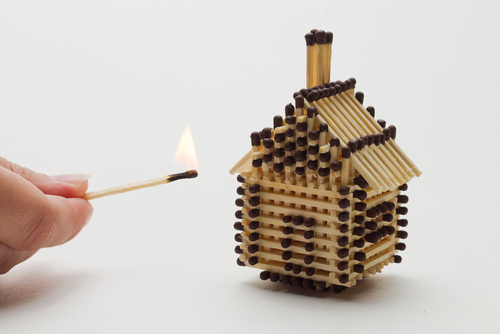
Install Fire Extinguishers
Store a fire extinguisher on every level of your home, and place them by exits whenever possible. It’s also a good idea to have an extinguisher in your garage. Home fire extinguishers should have an ABC rating, making them usable for all types of fires. If your home-based business includes sensitive electrical equipment, you should consider installing a Clean Agent extinguisher. Clean Agent extinguishers are ideal for areas with computers, data/document storage areas, and any other expensive electrical equipment. Though you should only consider using a fire extinguisher when a blaze is in the early stages — small and contained — they can be crucial in preventing significant destruction, and managing dangerous situations. In addition to having fire extinguishers in your home-based business, it’s important that you know how to use one before an emergency arises. Hands-on training is exciting and informative! The confidence you gain by using an extinguisher on a real fire is invaluable and knowing when to use an extinguisher is just as important as knowing when not to use one. Fire Extinguisher training instills the confidence to make that important decision when it matters most.
Fiction: All fire extinguishers are the same.
Fact: Each fire extinguisher has a specific purpose; not every extinguisher will work for every type of fire. For instance, ordinary combustibles fall into the category of Class A fires, and should be put out by a water, foam, dry chemical, water mist, cartridge operated dry chemical, or fast flow extinguisher. Class B, C, D, and K come with their own extinguisher suggestions as well. It’s important to be informed about which fire extinguisher to use in a given situation.
Install a Fire Sprinkler System
We can’t always predict when a fire will spring up, but we can take the steps necessary to put remedies in place, just in case they do. Fire sprinkler systems can react much more quickly than firefighters that must travel to the scene. These sprinkler systems can help drown out a fire before it becomes unmanageable. In fact, in homes with sprinklers, the average property loss is cut by about 70% compared to those homes that do not have sprinkler systems.
Fiction: Sprinklers can cause excessive water damage.
Fact: Sprinkler systems typically cause much less damage than the fire they are discharged to prevent.
Fiction: All sprinkler heads go off at the same time if one is triggered.
Fact: Each sprinkler head has a temperature gauge, ensuring that only the sprinkler heads necessary to address the fire are deployed at any given time.
Fiction: Sprinkler systems are too costly.
Fact: Sprinkler systems cost, on average, $1.16 per square foot.
Fiction: Sprinkler systems are unreliable and often misfire, causing unnecessary damage.
Fact: Sprinklers are historically predictable and reliable in their deployment.
Install Smoke Alarms
Smoke alarms are more than just decorative reminders that a fire in the home can be a problem. They can also cut down on the risk of major damage or even death due to an unnoticed spark and subsequent flame. One such device called DTM, a smoke detection device developed by four Spanish firefighters, enhances safety at home thanks to its quick activation, facilitating the evacuation of its occupants and preventing fire deaths. Smoke alarms should be placed in multiple areas of the home, especially in areas such as home offices where a good deal of technology is often located together in close proximity. And most importantly, fire alarms should be tested routinely and batteries should be checked and kept fresh throughout the year.
Fiction: All fire alarms are the same.
Fact: There are two standard fire alarms sold in the US. Photoelectric fire alarms detect smoke particles via a tiny light beam, whereas an ionization smoke alarm detects smoke particles that pass through two plates. These two types of alarms are best at detecting different types of fires.
Fiction: Fire alarms go off with plenty of time to get out of the house.
Fact: This is not always true. Experts estimate that you have just two minutes after an alarm goes off to get out of the house before you have a major fire on your hands.
Fiction: Traditional fire alarms always work.
Fact: The frequency of fire alarms is noticeable to individuals awake, but can be inadequate when an individual is sleeping. This is most evident with individuals who are very young, old, or those who sleep under the influence of drugs or alcohol.
Engage in Proper Electrical Practices
In 2011 alone, electrical fires within the home represented 13% of all home structure fires. And because of the increased number of electrical items typically housed in home offices, home-based businesses are at an even higher risk of fire-related damage. With multiple cords, warm computers, and high electricity usage, best practices are of utmost importance in keeping your business safe. Try to avoid extension cords and multi-plug adapters, and don’t extend wires through doors, ceilings, floors, or walls. Also be sure to replace damaged cords, plugs, or outlets, and maintain a 30-inch minimum clearance around all circuit panels in the home (and make sure you know exactly where they are located in case of emergency).
Fiction: It won’t happen to me.
Fact: Just because you are diligent in managing your home-based business, it doesn’t mean that electrical shorts, misfires, and unfortunate circumstances won’t befall you. Remain diligent and ready at all times, and make sure that your home office is always equipped with a fire extinguisher at hand.
Keep Important Business Documents in a Fire-Proof Safe
Although many documents can be stored online, you may have printed items or electronics such as hard drives that are irreplaceable, or at least whose destruction would be very undesirable. If possible, keep these items in a fire-proof safe so that if disaster does strike, you can come out of the experience with the paperwork and electronics necessary to help your business bounce back.
Fiction: All fireproof safes are the same.
Fact: Fireproof safes have varying degrees of safety, depending on whether you are trying to protect documents or electronics. Electronics require that you purchase a safe that does not exceed an internal temperature of 120 degrees Fahrenheit.
Fire safety is every home-based business owner’s responsibility. And adhering to best practices is the best way to keep your business safe. Ensure that you have proper preventive measures in place in the form of sprinklers, fire alarm systems, and fireproof safes. Many assumptions are made on the efficacy of fire safety systems and the chance that an individual’s business will be subject to an unexpected fire, but with numbers that show a whopping 1,298,000 fires reported in the United States in 2014 alone, fire safety is not a concern to be taken lightly. Solid preventive measures and a good understanding of the benefits and limitations of each type of protection can go a long way towards keeping your home and business free from fire damage.
Find a Home-Based Business to Start-Up >>> Hundreds of Business Listings.
















































